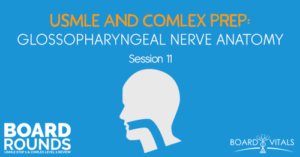You still have time to sign up with one of our amazing expert advisors! Learn More!

Today, we discuss a more straightforward, neuro-anatomy question about the glossopharyngeal nerve.
As always, we’re joined by Dr. Andrea Paul of Board Vitals. If you’re in the market for QBanks and practice tests for the USMLE/COMLEX, check out Board Vitals. Use the promo code BOARDROUNDS to save 15% on your purchase.
Which of the glands of the options below are innervated by the efferent autonomic fibers of the glossopharyngeal nerve?
You have to know what the glossopharyngeal nerve and what type of fibers are innervating the glands.
Answer choices:
(A) Nasal
(B) Submandibular
(C) Sublingual
(D) Parotid
(E) Lacrimal
Glosso refers to the tongue and pharyngeal refers to the pharynx area. So this is somewhere around the mouth. The interesting with glossopharyngeal is that it has a range of effects. Some of the places it touches would surprise you. But first, you can eliminate nasal. But the rest of the choices could be fair game.
This specific nerve has a lot of sensory – parasympathetic and motor functions. It’s tough to answer so this can be challenging to people. This nerve starts at the medulla and coming out of the jugular foramen. It’s traveling through both anteriorly and posteriorly. So it has a branch that goes to the inner ear.
Lacrimal refers to the tear ducts so you can get rid of this one too. Now, we’re down with three choices.
First, remember the motor functions. So it’s innervating the muscle in the pharynx and then you think through the sensory functions. Glossopharyngeal is sensory to the posterior third of the tongue or the back half of the tongue. If you can remember that section of the tongue, it leads you closer to the location of the gland that may be in that area. It’s also going up into the middle ear, the Eustachian tube for sensory function.
Anatomically, you start to think more up anterior than sublingual. Think of it as more of in the ear area. So the correct answer here is the Parotid gland, which is the only gland that doesn’t receive any autonomic innervations from the facial nerve. So it receives that from the glossopharyngeal nerve. This is the main differentiator. Hence, the exam likes to ask about it.
The posterior third of the tongue and the middle ear are things they love to ask about glossopharyngeal. Also, know which muscles are innervated, which is the stylopharyngeus in the pharynx. Also, try to remember the path and the branches. It sends a branch up to the middle ear. There are five other branches. One goes to the stylopharyngeus muscle, one is the pharyngeal branch, one is tonsilar, one is sublingual, and then one goes to the parotid body and sinus. You can draw this to help give you a visualization.
Afferent refers to the sensory nerves coming back towards the central nervous system and efferent refers to “going away” for motor function. In terms of understanding parasympathetic vs sympathetic, just remember that most glandular effects are parasympathetic just like most of your organs.
Check out the QBank and practice tests over at Board Vitals to help you be prepared for your exam. They have over 1,750 questions for USMLE and over 1,500 questions for COMLEX. Get a 1-month, 3-month, or 6-month plan. They all come with a free trial. No credit card required. Use the promo code BOARDROUNDS to save 15% on your purchase.
Board Vitals (promo code BOARDROUNDS)

Lorem ipsum dolor sit amet, consectetur adipiscing elit
I just received my admission to XXXXX! This is unreal and almost feels like I am dreaming. I want to thank you for all of your help with my application. I cannot overstate how influential your guidance and insight have been with this result and I am eternally grateful for your support!
IM SO HAPPY!!!! THANK YOU SO MUCH FOR ALL YOUR HELP, IM INDEBTED TO YOU! Truly, thank you so much for all your help. Thank you doesnt do enough.
I want to take a few moments and thank you for all of your very instructive, kind and consistent feedback and support through my applications and it is your wishes, feedback, and most importantly your blessings that have landed me the acceptance!
I got into XXXXX this morning!!!! It still has not hit me that I will be a doctor now!! Thank you for all your help, your words and motivation have brought me to this point.
I wanted to once again express my heartfelt gratitude for your help in providing feedback during my secondary applications. Your guidance has been instrumental in my journey.
Just wanted to share my wonderful news! I received my first medical school acceptance! Thank you for all that you do for us Application Academy!!!
I am excited to tell you that I just got my third interview invite from XXXXX today! I can’t believe it. I didn’t even know if I was good enough to get one, let alone three – by mid-September. Thank you so much for all of your help and support up to this point; I would not be in this position without it!!
I wanted to thank you for helping me prepare for my XXXXX interview. Even in a 30-minute advising session, I learned so much from you. Thank you for believing in me, and here’s to another potential success story from one of your advisees!
I just received an acceptance with XXXXX! This is so exciting and such a huge relief and so nice to have one of our top choice schools! I also received an interview with XXXXX which brings the total up to 20 interviews! Thank so much, none of this would have been possible without you!

Join our newsletter to stay up to date
* By subscribing you agree to with our Privacy Policy and provide consent to receive updates from our company.
Resources
Advising Services
Podcasts & Youtube
Books
About
Deal Lasts for

"*" indicates required fields